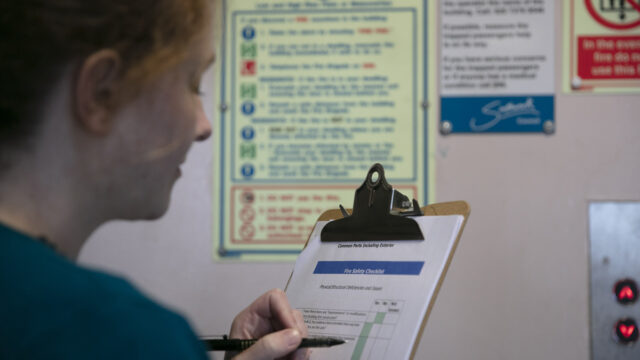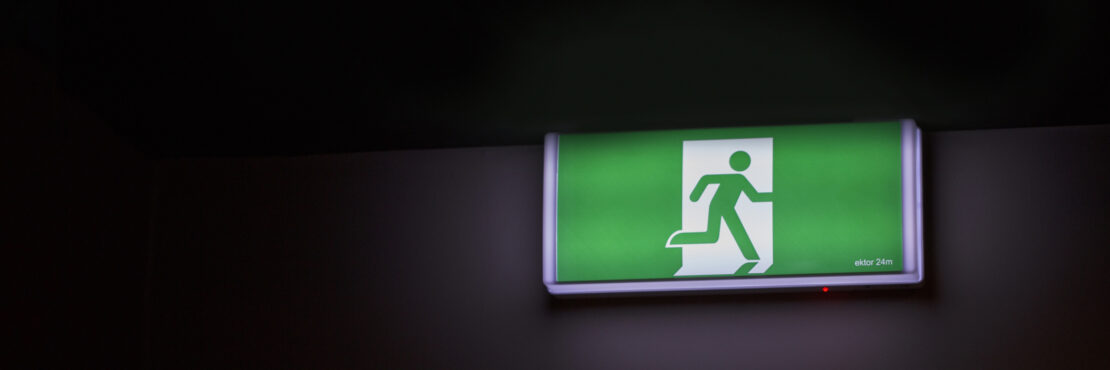In the UK, there are laws that are designed to keep you safe from fire.
Building regulations should mean that there’s a smaller chance of a fire starting in your block, and that it if one does start, it spreads more slowly. Housing law says that your landlord must put measures in place and take regular actions to keep your block fire safe.
As a tenant, you can also help ensure that your own flat is as safe from fire as possible.
How building regulations help make tower blocks safer from fire
Building regulations describe the materials and methods that must be used when erecting a new block; and they also ensure that converted or older buildings are brought up to standard.
- Compartmentation Flats should all be individually sealed units, so that if a fire starts in one flat, it cannot spread to another one for at least an hour.
This is called ‘compartmentation’, and you can read a bit more about it on our pages about cracks in walls and leaking windows. Also see this page on Large Panel System blocks.
Compartmentation can be achieved by ensuring plasterboard on walls and ceilings is of the right thickness to hold back fire for 60 minutes, and installing fire doors. - Fire doors These must also be able to hold back fire for 60 minutes. Landlords must ensure that they are kept shut, generally with an automatic door closer.
There must be no gaps between the door and the frame: to help this they can install fire seals which expand in heat to fill any small gaps through which fire or smoke might spread. - Dry risers Tower blocks over a certain height (where the floor is between 18 & 60 meters above ground level, which usually means buildings of between six and 17 storeys) must be fitted with ‘dry risers’. These are empty pipes that the fire service can use to pump water to every floor if there’s a fire. They should be regularly serviced.
- Clearly marked, safe escape routes Any building over three storeys high must have the escape route marked with signs.
- Emergency lighting Any building taller than two storeys must have emergency lighting along the escape route/s.
What landlords must do to help make tower blocks safer from fire
- Regular inspections In England and Wales, landlords must make sure there’s a fire risk assessment every year. In Scotland, the law is different, but the landlord is still responsible for keeping you safe from fire.
- Maintenance Your landlord has the responsibility of keeping fire safety measures, like dry risers, door closers, sprinklers and emergency lighting in good order.
- Keeping corridors clear Blocked corridors can be dangerous in the case of a fire, especially for disabled and elderly people, those under the influence of medication, drugs or alcohol and those with children and pets. Escape routes must not be used for storage or have furniture placed in them. It’s also important that there are no flammable materials: these could include fuel, heaters, a build up of mail, rubbish bags or even festive decorations. Landlords must make sure that corridors are clear, and tenants can obviously help with this.
- Installing and maintaining smoke and fire alarms The requirements vary according to the number of storeys in the block and how ‘high risk’ the occupiers are (including their level of mobility); in Scotland, every home must have interlinked fire and smoke detectors.
- Providing and maintaining fire extinguishers (and possibly sprinklers) Your landlord should make sure that you know how to use the fire extinguishers: there may be instructions in the documents you received when moving in.
- Making sure tenants are aware of the emergency plan Everyone in the building should know what to do in case of a fire, where the escape routes are, which doors lead to an outdoor space, etc. This information may be displayed on signs in the common areas.
What you can do as a tenant
- Install smoke alarms These might be provided by your landlord and in Scotland that’s a legal requirement, but otherwise you should install your own. Check them regularly and replace the batteries annually.
- Keep a fire blanket and maybe a fire extinguisher You can put these in the kitchen and anywhere else where there’s a risk of fire. However, the fire service recommend that they should be used only on small fires; for any larger fires you should evacuate the building and call 999.
- Keep escape routes clear As mentioned above, you should not store anything in the corridors.
- Make sure your electrical goods and fittings are safe Check the wiring of items such as lamps, white goods and heaters, especially if they are from a country with fewer laws around safety, or second hand. If your landlord provided an item that you think may not be fire safe, let them know. Don’t overload sockets with lots of plugs, and switch things off or unplug them at night.
- Keep safe habits Burning candles, smoking and cooking are all activities where you should be careful that nothing can catch fire and that you have extinguished the flame afterwards. Don’t store flammable materials such as fuel or oil-soaked rags.
- Have a plan Think through how you would escape if there was a fire. Include any children, older or disabled people and pets in your plans.
- Ask to see the fire risk assessment (England and Wales). It’s your right to ask your landlord when the fire assessment was last conducted, and what the results were.
Read this
Related guides


Reference
What laws protect social tower block tenants from fire in Scotland?


Guide
It’s important that corridors are kept clear because in case of emergency, everyone needs to be able to make a quick exit.


Reference
Every tower block should have regular Fire Risk Assessments – they’re a legal requirement. But what does it mean for you, the tenant?


Letter
Ask your landlord when the last Fire Risk Assessment was held and how you can see it for yourself.


Letter
If your landlord is breaching fire safety regulations, you can contact your local Fire Service.


Letter
A letter which you can use to report a fire risk in your tower block to your landlord.












